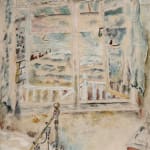David Jones 1895-1974
frame: H. 76.5 x W. 64.5 cm
David Jones was a highly gifted, creative spirit whose deep intellect and interests were manifested in his paintings, writings, poetry and friendships. They reveal one of the great Modernists of his age – a critical thinker occupying numerous intellectual circles centred around art, religion, philosophy and poetry. A shy man, he was loathe to self-promotion yet the body of work he left is testament to his broad talents and his central place within the ‘Arts’ in 20th century Britain.
The Bedstead, Portslade, from 1929, is an exemplary work which belongs to the most fruitful period of Jones’ artistic career. Reflecting in 1962, he considered that the Portslade pictures ‘are, probably, quite the best I’ve done.’ (quoted in Thomas Dilworth, David Jones: Engrave, Soldier, Painter Poet, Jonathan Cape, London, 2017, p. 107). John Rothenstein (art historian and Tate Director from 1938-64), and a champion of contemporary British artists, would also consider them ‘among the most original creations in modern painting’ (T. Dilworth, op. cit., p.122). A related work from 1929, The Terrace, is in the Tate Collection.
Portslade, located near Hove, was where Jones’ parents were lent a house during the summer months. It was situated on the sea-front, so much so that as Jones recalled, ‘if the weather were at all rough, surf and spray broke on the seaward balconies!’ Jones used a frame motif in these works akin to the paintings of Matisse or Bonnard with which Jones was familiar. To great effect, Jones blurs the boundaries between inside and out, infusing the works with a breezy airiness. ‘I always work from the window of a house if it is at all possible. I like looking out on the world from a reasonably sheltered position. I can't paint in the wind, and I like the indoors-outdoors, contained yet limitless feeling of windows and doors.’
This is keenly felt in The Bedstead, Portslade, where the open window beckons us to the expanse of sea beyond the confines of the bedroom. Perspective almost merges the sea and bedroom into one, while the free-flowing lines and daubs of colour give the work a rhythmical, poetical quality, to which end the medium of watercolour was entirely suited. It reflected too his sense of the world, in which he detected ‘a feeling of transparency and…metamorphosis’ (Dilworth, op. cit., p. 121).
Jones plays with pictorial space and compositional structure, contrasting the static and the dynamic, the near and far, the horizontal and the vertical. One is not confronted with a frozen moment but one of motion: the sea rolls in, curtains billow in the breeze and the light changes.
The year before Jones painted The Bedstead, Portslade, he had been elected a member of the 7 & 5 Society, nominated by Ben Nicholson, and thereby included amongst some of the leading modernist voices in British art, including Ben and Winifred Nicholson, Christopher Wood, Ivon Hitchens, France Hodgkins and Cedric Morris. Jones had met Nicholson through H. S. (Jim) Ede, curator of the Tate, who was central to the encouragement of British Modernism and an important supporter of Jones. Jones first visited Ede in his house in Hampstead in 1924, from which point a firm relationship formed. He would frequently stay with the Ede family and was a regular attendee at their Sunday salons. It was through Ede that Jones also met Helen Sutherland who became his greatest patron – Jones would visit her at Rock Hall in Northumberland and soon she amassed a significant number of Jones’ paintings which hung alongside her Ben Nicholsons.
In Ede’s preface to the Society’s seventh exhibition in January 1927, he wrote how its aim was 'to break quite clearly from the representational in its photographic sense, though not like the Cubists to abandon known shapes. It is to use the everyday objects, but with such a swing and flow that they become living things, they fall into rhythm in the same sort of way that music does, but their vitality comes through colour and form instead of sound and time. They are not so much pictures as ideas settled for the moment on canvas, but ever ready to take fight into some new life.' Such a sentiment chimes closely with Jones’ own pictorial concerns evident in The Bedstead, Portslade.
Jones did occasionally paint in oil but it was with his watercolours of this period that Jones staked his reputation as one of the great British watercolourists - an heir to Palmer, Blake and extending back to the medieval illuminators - with an immediately recognisable style peculiarly his own. There is joy in the movement of these works - through the deftness of his brushwork and skill with the medium; they are compositions that invite us into perceive a world of light and shade and space, ultimately affirming what Jones held as paramount to painting: "The goal of painting is delight."
Provenance
Austin Desmond, London;Acquired from the above 2001 by the present owner




